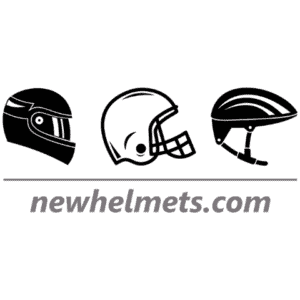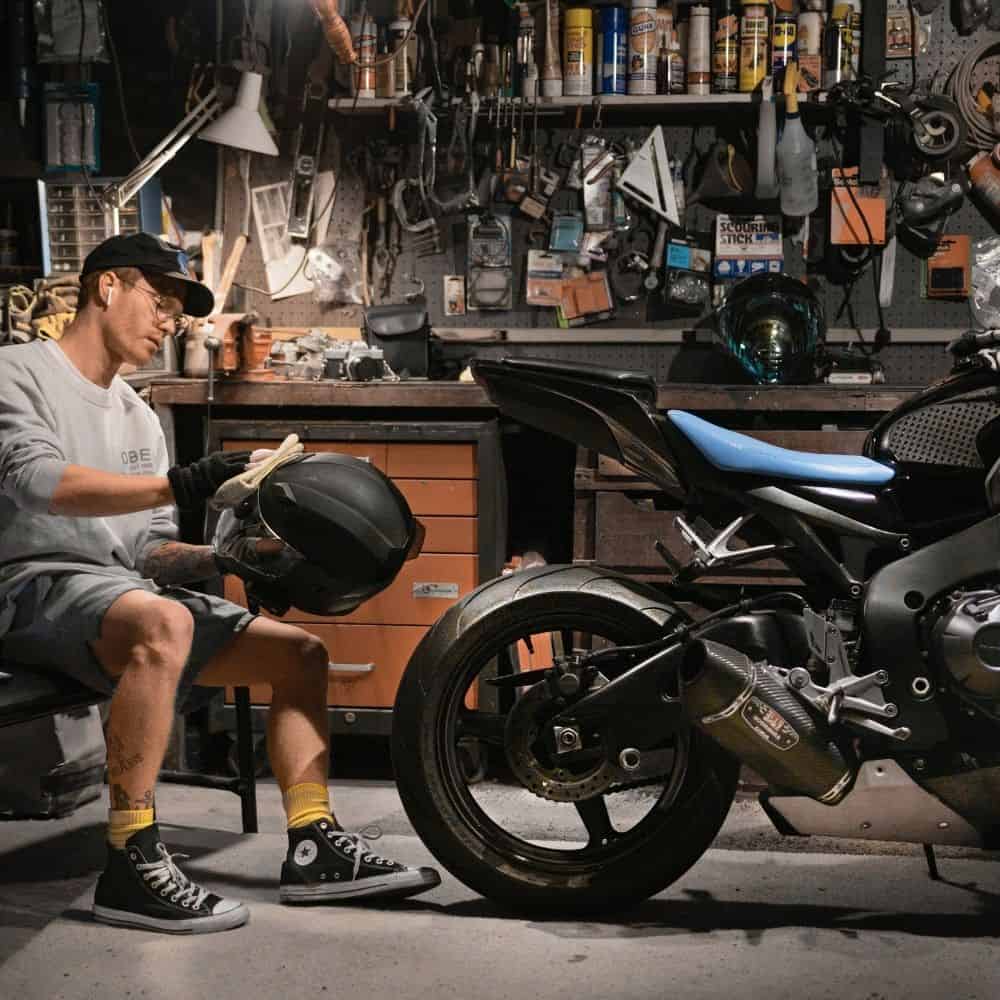The motorcycle helmet is the most important piece of safety equipment in a motorcyclist arsenal. If you have ever wondered what they are made of or what the parts are called, then here is the answer.
A motorcycle helmet is made from the following materials:
| Component | Material |
| Outer shell | Polycarbonate/Fiberglass/Carbon Fiber |
| Inner liner | EPS foam/Koroyd |
| Comfort liner | Foam, Nylon |
| Retention system | Kevlar, Nylon |
| Visor | Thermoplastic like Acrylic and Polycarbonates |
| Vents | Thermoplastic |
What are helmets made of?
Comfort lining
You may not know, but the inside of a helmet is called the comfort lining. Its job is to make the helmet stay in position on your head and make it comfortable. It would be a nightmare to ride around with a carbon fiber lid without the padding. The most crucial aspect of helmet safety is how it is positioned on your head. An ill-fitting helmet is useless in an accident as it will inevitably come off when you need it the most. Always ensure you have a helmet that fits the shape of your head.
There are generally two parts to the comfort liner – the skull pad and cheek pads, and they are usually made from foam and nylon. Many manufacturers are now introducing magnetic cheek pads that are designed to be easily removable in the event of an accident.
Modern helmets have anti-microbial and anti-odor properties to keep them clean and fresh for as long as possible. A good comfort lining will help to reduce noise, wick away moisture. More expensive models have a removable liner that can be machine washed.
EPS inner lining
The inner lining is made of EPS. (Expanded Polystyrene) Its job is to absorb the force of an impact before it reaches the skull. The liner is made of crushable foam cells, which crush under external forces to soften the blow. Once they have been crushed, they are useless, and the helmet will need to be replaced. Each manufacturer constructs this layer differently depending on their research and the intended objectives, but generally, there are one or two layers of EPS foam with varying densities placed in strategic areas around the rider’s head.
Some manufacturers have started to produce inner linings from a material called Koroyd. Thousands of small plastic tubes are glued together in a honeycomb pattern. Unlike EPS, these tubes contain air. Koroyd dissipates the forces of impact much better than EPS. Additionally, Koroyd has dramatically improved airflow. Air can flow directly through the honeycomb from the front to the back of the helmet freely, this is impossible with an EPS liner.
Outer shell
The outer shell is the first layer of defense and arguably the most important part of a crash helmet. It is the part everybody can see. Motorcycle helmet owners love to add custom paint schemes and decals to make them more personalized. However, its primary function is to protect the head from impact. It is designed to dissipate force across the helmet’s surface and away from the head, with minimal deformation. They are designed to withstand penetration by high-speed objects too. For example, Arai uses a proprietary carbon fiber material used in the construction of commercial airliners. Manufacturers choose from three different materials to construct the outer shell, and they are selected for their distinct individual properties. However, manufacturers will experiment with the mix of materials in the outer shell and are continuously innovating to achieve a lighter and more robust product.
Polycarbonate
Polycarbonate is a thermoplastic that is injection molded into the desired shape. The manufacturing process is relatively inexpensive, and therefore, you often find this material in cheaper mass-produced helmets. The disadvantage of polycarbonate is that it is thicker and heavier.
Fiberglass/Composite fiber
These types of helmets are time-consuming and labor-intensive to manufacture. Usually, a technician will add layers of fiberglass into a mold and bond them together with organic fibers and resin. Each layer is painstakingly positioned by hand, creating a weave of incredibly strong, lightweight, and flexible material. The labor costs of these helmets inevitably push the price up.
Carbon fiber
These helmets are constructed similarly to fiberglass models, but this wonder material is lighter and stronger still. I found a particularly useful article online from Arai, the Japanese manufacturer of world-renowned racing helmets. They state that when manufacturing the RX-7 Racing Carbon, they use eleven layers of premium carbon fiber. Here is a link to the article if you would like to know more about the materials Arai uses in manufacturing helmets.
Each manufacturer will have a proprietary mix of carbon fiber with other materials like Kevlar and Aramid. These materials are then bonded together with patented techniques to achieve maximum strength and the lightest possible weight. Lids made from a carbon fiber mixture are not cheap, and they are often the highest spec models the manufacturers will produce.
Visor
Acrylic and polycarbonate are used to construct the helmet’s visor. Visors have all kinds of different properties to stop UV rays, fogging up, and scratches, but its primary function is to keep out bugs, dust, and water.
Visors are also put through similar stringent tests as the outer shell to make sure they absorb impact and do not come apart when traveling at speed.
Retention system
The good old chin strap is usually made from Nylon or Kevlar because of their high tensile strength. There are two different types of locking mechanisms that keep the helmet on the head. One is the D-ring adopted by most racers, and the other is the quick-release ratchet, which is more common amongst everyday riders. There is not much difference in the webbing system, and each method is as safe as the other.
Ventilation system
The helmet ventilation system is a brilliant technical innovation. It helps to circulate cool air around the head while expelling warm air. Vents are usually found in the chin bar, forward-facing, or backward facing on the shell. The vents are made from thermoplastic and are typically attached to pre-drilled holes with a quick-release retention system. Most manufacturers sell vent kits so you can choose the shape and size to suit you.
Latest innovative materials in motorcycle helmets
Companies are now starting to understand the need to protect against rotational acceleration from certain types of impacts. Inside these types of helmets, they fit a movable thermoplastic mechanism that mimics the way the head protects the brain in real life. This mechanism is called MIPS. See this YouTube video from Bell motorcycles about how they use the MIPS system.
Most research is carried out on creating a stronger outer shell. Arai’s latest innovation is the patented PB-SNC (Peripheral Belting-Structural Net Composite). It is a shell made from fiberglass but with a strengthening belt attached to the outside. It is positioned just above the visor opening, and its purpose is to stiffen the helmet to provide even greater protection. The belt was originally created for their Formula One racing helmet.
Manufacturers spend millions each year on research and development to make their helmets safer. Some of them produce models exclusively for elite motorsports like Formula One and MotoGP. If you would like to know how much a Formula One helmet costs, then click the link and read my post.
If this is your first visit to my blog, welcome and I hope you have enjoyed it. I discuss all aspects of owning or buying new helmets. From crash helmets to the humble hard hat, this blog has the answers. I talk about the best brands, safety ratings, value, and maintenance. Please, choose another article if you would like to know more.
My name is Matt, and I am a helmet sports enthusiast. I love climbing, motorcycling, kayaking, amongst other things. But no matter what sport you love, please stay safe.


